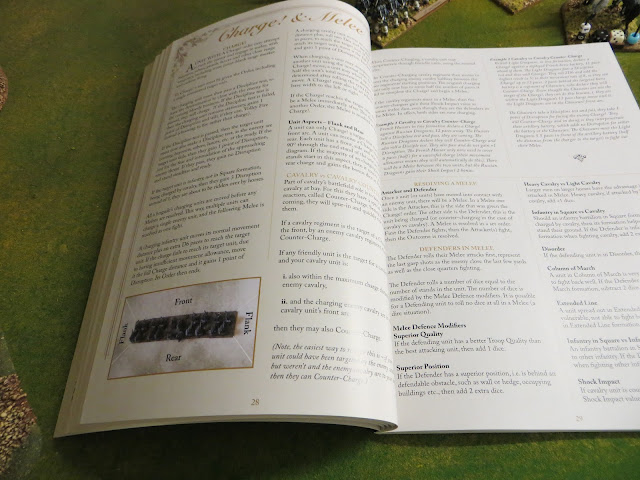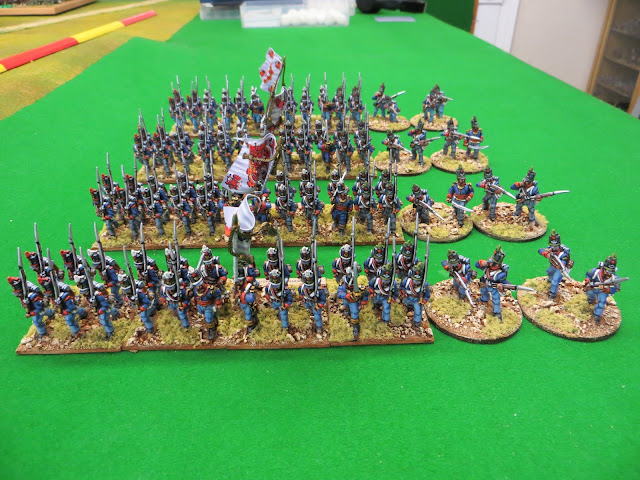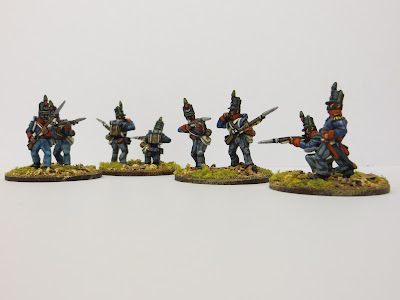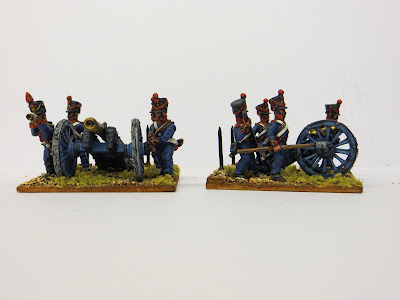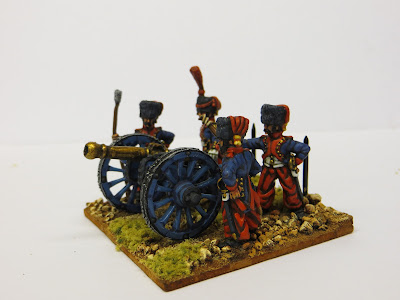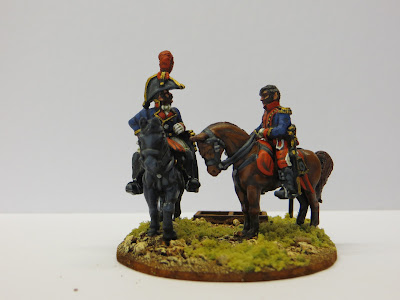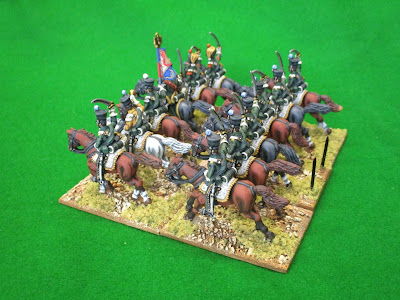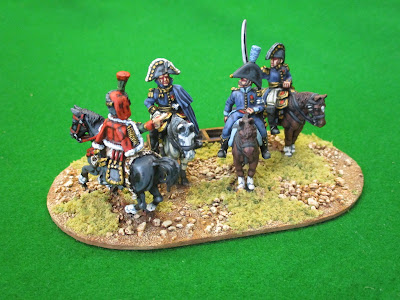Firstly, this is not a full review, it's simply my first impression of the core rules, especially as regards to them being used by me, and my opinion of the product in general. There is far too much in the book to review in a single concise blog post. However, there is a lot of buzz about these rules so I'll join in the chorus with my two pennies worth.
My copy of this rules set, with accompanying boxed deck of 56 cards, arrived yesterday and on opening the box my first impression was favourable. The book, 127 numbered pages, is a quality (softback) affair; the print seems to be well organised and laid out in clearly labelled paragraphs; it's printed in a nicely sized font; from first reading, the writing style is excellent. The pictures (prints of original paintings, as well as the usual photos of some nice model soldiers, some of which are used as explanatory diagrams) are not excessive - this is not a fluffed out glossy picture book, for a change. The only thing I'm worried about is the softback binding which at the moment, it has to be said, looks nice and tight - however, I'm yet to buy an unstapled softback rules book which, if used a lot, has managed to remain so over time and time will tell.
The die cut cards (proper playing cards, if on the narrow side of standard) are very nicely presented. They are a quality product. I have immediately put mine into protective card sleeves and will put their box away for safe keeping. I would advise everyone to do this because cards deteriorate rapidly on a wargames table because wargames table-tops tend to be slightly abrasive and slightly 'dirty'. The cards cannot be bought separately from the rules - it's a £30 deck of cards folks; you can't play the game without it; take care of it.
The book is divided into five major sections. The core rules, which are quite short at 36 pages, followed by a section on 'Battles and Battlefields' covering terrain, deployment, scouting, etc; a section on 'Armies and Theatres' which covers army building, brigade construction, commanders, reserves and special unit types, etc; and then the last two sections deal with setting up battles for '1813-14 the War of the 6th Coalition' and '1815 the War of the Seventh Coalition' - neither of which I have troops for but are generally instructive as guidelines for the armies and campaigns that the book doesn't cover. The lack of initial scope (other campaigns are not specifically covered at all) will be a disappointment to some players, especially those without the time or inclination to do some spade work but, I expect supplements for other sub-periods will be forthcoming. Nor is the rulebook an 'all in guide' for the beginner - prior knowledge of Napoleonic warfare is essential.
Getting onto the rules themselves. Firstly, scale of game. Having only seen reviews and a couple of videos of the game this was my chief concern. Could I use the rules to fight the scale of battle I want to fight using the rules without 'house amendment'. I'm glad to say that, from first read through, I can. The rules allow for battles with two to five (typically three or four) 'brigades' representing a 'division' and its reserves: Brigades, according to the rules, can each be anything between two and six units, plus artillery, strong (they can be up to seven strong according to the coalition lists): When playing this (on-table) 'division', it should be seen as one of several fighting on a wider (off table) front, with abstracted rules to say how what is going on elsewhere effects your own (on table) effort.
As you know, I don't play with brigades. I play with brigade-less divisions made up of units each representing 1000 infantry or 500 cavalry - for the Peninsular that typically works out at four to six infantry units, or two to four cavalry units, per division. These numbers fall quite nicely within the parameters of the game: Instead of what they call 'brigades' I'll field what I call 'divisions', and as I usually field three to four this looks to fall nicely within the rule parameters as well; corps commanders will substitute for division commanders, and army commanders will substitute for corps. I really can't see how playing at this scale will effect how the game is played very much: I believe the term is 'bath-tubbing'.
Although I knew that base size was unimportant, the next concern I had was that the rules allow for, indeed they encourage, different sized units. A stand equates to 150 infantry: Consequently, infantry units vary between two and six stands strong. Because of the way I field my divisions all of my units are the same size (four stands, representing 1000 men). Will this be a problem? Obviously, if the rules cover everything between two and six stands they will cover four stands but, will this take away a significant nuance in the way things are set up. Until the game is played it is hard to tell but, I suspect not.
Measurements are stated as paces and paces are left to the player to define. Typically in 28mm, one pace is 1". Movement distances are what we all expect - infantry in a column of attack move 6; line 4; column 8. Heavy cavalry 50% more, light cavalry 100% more. Dice are used to determine the effect of terrain. Musketry range for a volley is 10. 8pdrs can shoot canister 10 and round shot or shrapnel 40.
Recommended table size for 28mm is roughly 6 x 4, larger being considered a nice to have: Lucky me!
I'm not going to dwell at all on the fire and melee combat mechanics. Although they vary from one set of rules to another they are, to a large extent, the easiest thing to get right. To my mind they are also the least interesting part of any rule set. Mr Kinrade has written rules before. I expect that he knows his onions and I'm prepared to take his combat mechanics on trust. Suffice to say that it is a D6 per stand game with fairly standard modifiers; they look elegant enough to allow for swift play without constant reference to the very short (1 page) QRS. However, there are two things worth mentioning. Firstly, and importantly in my view, skirmishers feature and look to be an important tool. Secondly, the way 'damage' (disruptions) is taken and recovered looks interesting - play will tell.
Units stay on table until disruptions are greater than stands, at which point the unit is destroyed at the end of a turn. Disruptions are taken during fire, melee, for repetitive orders and some movements - possibly other things that have slipped my mind too.
Now the important thing: Command and control. To my mind, this is the most important thing in any set of rules and the game mechanics that govern it should always lie at the game's heart: It is what differentiates one set of rules from another, and either makes a game good, bad, or meh. They are certainly at the core of this set of rules so Mr. Kinrade has my respect for that.
On first reading, the mechanics governing this aspect of the game look right up my street. In general, everything you do is governed by the playing of 'Action Cards'. At the start of each turn the player is dealt a hand of cards (two plus the number of brigade commanders 'not at risk'). These are played alternately by the players to activate units in a chosen 'brigade' by giving them an order; or the card may be played as an event; or played to rally.
The number of orders a card allows is restricted (each card has a number of 'order points', 2 - 6, printed on it). Units in the brigade, up to the card's order points number, can be given one order each (though distance to the commander has an effect on how many order points the order will cost). These orders are quite specific: move is an order, change formation is an order, wheeling ('manoeuvre') is an order, fire is an order, charge is an order, etc. This will severely limit what players can do and I like that. The 'brigade' can be activated again on the player's next card but this causes disruption (damage) to its units.
There seems to be no limit on how many consecutive order cards can be played by the player on a 'brigade', except that each time a consecutive card is played on a single brigade, even turn to turn, it causes disruption (damage) to the units that receive orders. The author suggests that a marker is placed next to the last 'brigadier' to issue orders so that this is not forgotten. This will naturally limit the number of successive actions a player will wish to order a brigade's units to carry out and represents them being overburdened within the timescale of a turn. It's worth noting that events and rallies do not incur the same disruption on a brigade.
The card can be used to play an event. Events are varied but include things like 'Fierce Cavalry Charge (6+)', 'Commander [enemy] Wounded (5+) ', and so forth. They are not automatic but rely on a simple chance roll on D6, e.g. 5+. In themselves they are not battle winning but can unpredictably change conditions locally to something advantageous. In short, they allow you to throw a spanner at your opponent.
There are also six 'objective missions' which can be played as events, such as 'Take The High Ground', which if achieved wins victory points. I've not come across this before: Its novel and slightly abstract (because the 'mission' might not seem that important in relation to how the game looks) but, again I like the idea. Look out, incoming spanner!
Last of all a card can be used to rally disruptions from a unit. There are several ways this can be done. The most interesting is to swap one stand for two disruptions - effectively converting disruptions into physical unit casualties. I think this is quite novel and might actually be something very clever - game play will tell.
At the end of every turn there is an end phase. Each side goes through this, deciding if reserves arrive, removing units with more disruptions than stands and gaining victory points for them, and so on.
Victory points decide who wins and when. They are amassed during a game for effectively killing units, when the enemy rallies units (interesting), gaining game objective points, etc. When your VPs are more than the enemy's break point total (his points per unit) you win the game. Most rules seem to have something similar these days so I will not go into these in any detail but, they look reasonable enough and will steer a player's overall 'game strategy' to gain ascendancy.
Then, new Action Cards are dealt for the start of the next turn.
When the Action Card deck is completely depleted all of the cards are collected together again and shuffled. Six cards are then permanently removed sight unseen before Action Cards continue to be dealt and play can start again (BTW, six cards are removed in a similar way on the first turn too, so you can never be sure what's in the deck). If victory has not been achieved before the cards 'run out' (a very long game?) it's nightfall and the game will end in a draw. So, the game even has a natural end to it - that's a nice touch.
So, after reading through the first two sections, and only browsing the others, that's it. There is a lot in the first sections and I'll need to read through them again before moving onto the others. All in all, this book is packed with 'extra bits' and I don't expect to be fully conversant for some time. One thing I'm sure of is that the initial learning curve is too steep to play the 'whole game' straight out of the box unless an experienced player is on hand to show you the ropes. However, at their core, the basic rules are quite simple. I don't think the rules will require more than one game for the players to get the basics; all else will surely follow in the way most rules are learnt. So, that's my plan: The next game here will be a small Soldiers of Napoleon practice game featuring two or three of my 'divisions' / their 'brigades' a side. I'll do a short follow up report on how this goes.
As I mentioned at the start of this post, there has been quite a lot of hype and buzz around these rules. I think they will be a fun set that lead to exciting games and in consequence I think they will become very popular. So, I'm going to stick my neck out and tell you to take a punt before they sell out and you need to wait for a reprint - I don't have any insider information so I don't know if this will actually happen but, I think it might. The rules are available from Gripping Beast.
For another review, here's a link to one by Mark (Extra Crispy) Severin.

